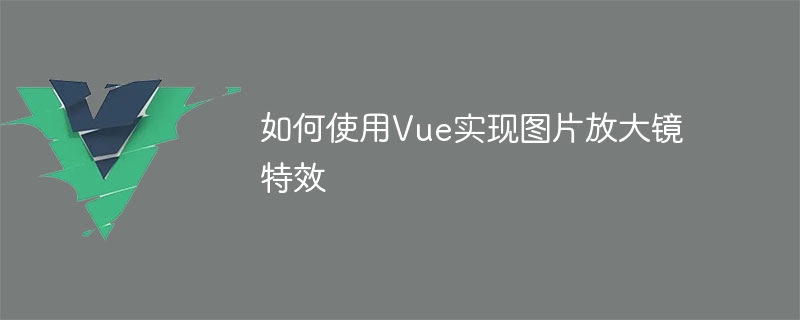

How to use Vue to implement picture magnifying glass effects
Introduction:
With the continuous development of Internet technology, pictures play an increasingly important role in our daily lives. important role. In order to improve user experience and visual effects, picture magnifying glass effects are widely used in web design. This article will introduce how to use the Vue framework to implement a simple picture magnifying glass effect, and give specific code examples.
1. Preparation:
Before you start, please make sure you have correctly installed the Vue framework and created a Vue project.
2. Component design:
We will use Vue’s componentization idea to realize the picture magnifying glass effect. Components can improve the reusability and maintainability of the code. In this example, we need to create two components.
<template>
<div class="main-image">
<img :src="imageSrc" ref="mainImg" @mousemove="onMouseMove" @mouseenter="onMouseEnter" @mouseleave="onMouseLeave" alt="How to use Vue to implement picture magnifying glass effects" >
<div class="magnifier" v-if="showMagnifier" :style="{backgroundImage: 'url(' + imageSrc + ')', backgroundPosition: bgPos}"></div>
</div>
</template>
<script>
export default {
props: {
imageSrc: {
type: String,
required: true
}
},
data() {
return {
showMagnifier: false,
bgPos: '',
}
},
methods: {
onMouseMove(e) {
const img = this.$refs.mainImg;
const rect = img.getBoundingClientRect();
const x = e.clientX - rect.left;
const y = e.clientY - rect.top;
const bgPosX = x / img.offsetWidth * 100;
const bgPosY = y / img.offsetHeight * 100;
this.bgPos = `${bgPosX}% ${bgPosY}%`;
},
onMouseEnter() {
this.showMagnifier = true;
},
onMouseLeave() {
this.showMagnifier = false;
}
}
}
</script>
<style>
.main-image {
position: relative;
}
.main-image img {
max-width: 100%;
}
.magnifier {
position: absolute;
z-index: 99;
width: 200px;
height: 200px;
border: 1px solid #ccc;
background-repeat: no-repeat;
}
</style><template>
<div class="thumbnail">
<div v-for="image in thumbnailList" :key="image" @click="onThumbnailClick(image)">
<img :src="image" alt="thumbnail">
</div>
</div>
</template>
<script>
export default {
data() {
return {
thumbnailList: [
'https://example.com/image1.jpg',
'https://example.com/image2.jpg',
'https://example.com/image3.jpg'
],
currentImage: ''
}
},
methods: {
onThumbnailClick(image) {
this.currentImage = image;
}
}
}
</script>
<style>
.thumbnail {
display: flex;
}
.thumbnail img {
width: 100px;
height: 100px;
margin-right: 10px;
cursor: pointer;
}
</style>3. Page layout:
In this example, we need to introduce the main image component and thumbnail component into the root component and pass them through props respectively. The address of the image. The following is a simple page layout example:
<template>
<div class="wrapper">
<main-image :imageSrc="currentImage"></main-image>
<thumbnail></thumbnail>
</div>
</template>
<script>
import MainImage from './MainImage.vue';
import Thumbnail from './Thumbnail.vue';
export default {
components: {
MainImage,
Thumbnail
},
data() {
return {
currentImage: ''
}
},
mounted() {
// 设置默认的主图地址
this.currentImage = 'https://example.com/defaultImage.jpg';
}
}
</script>
<style>
.wrapper {
display: flex;
justify-content: space-between;
align-items: center;
}
</style>Summary:
Through the above code example, we can see how to use the Vue framework to implement a simple picture magnifying glass effect. The main image component is responsible for displaying the original image and handling mouse movement events, and the thumbnail component is responsible for displaying the thumbnail list and switching the main image. Combining these two components and introducing them in the root component can achieve the effect of a picture magnifying glass. I hope this article will help you understand how to use Vue to achieve the picture magnifying glass effect.
Note: The above code example is a simplified version and may need to be adjusted and expanded according to specific needs during actual use.
The above is the detailed content of How to use Vue to implement picture magnifying glass effects. For more information, please follow other related articles on the PHP Chinese website!